Original 1977 Foden Fleetmaster press vehicle restored
Posted by Chris Graham on 24th November 2023
The Fleetmaster was Foden’s approach to the component truck, but all done in the Sandbach style, says Ian Shaw.

Steve Mayle’s 1977 Fleetmaster was the original Foden press vehicle.
When searching for trucks to feature in these pages, all manner of routes and co-incidences can apply, turning up interesting vehicles along the way. If we set out to find one particular make and model, then the difficulties arise. The late 1970s were the pinnacle of the component truck, many established makes had been swallowed-up by BL and only their (now tarnished) badges could separate them, since beneath it was all Leyland ‘680’ and Albion axles, no matter what it said on the radiator. Elsewhere ERF and Seddon-Atkinson ran parallel courses with their C-Series and 400/401 takes on the eight-wheeler and distribution tractor market.
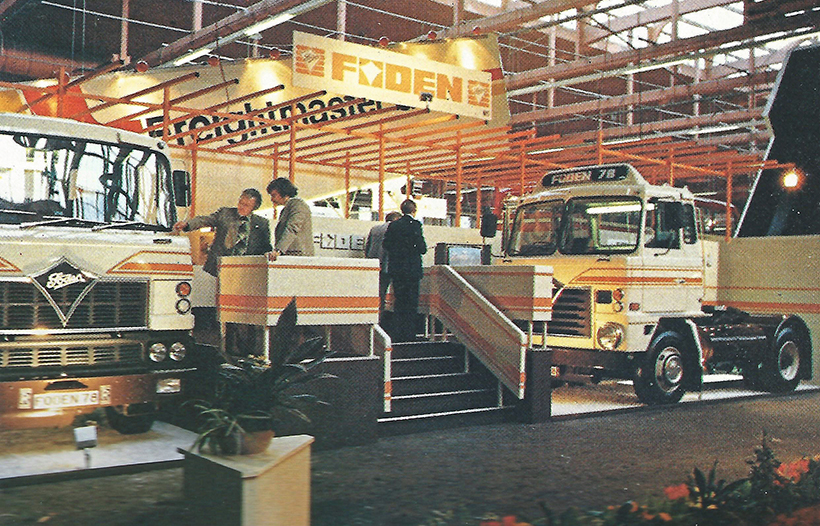
In public, at Kelvin Hall, Glasgow in November 1977.
Foden was one of the last to succumb, but from a peak of building its own chassis, engines and drivetrain it finally went the component truck route, the clearest indicator of which was the Fleetmaster. To find a good Fleetmaster today is not easy – the ravages of corrosion to chassis and cabs see to that – to find a sympathetically-restored example is even harder and one with a complete documented history something of a holy grail search. To attempt finding Foden’s original launch truck – the actual vehicle that the press photographed at its unveiling and then drove for their first road tests, restored to the condition when it first saw light, would, of course, be utterly ridiculous. So here it is!
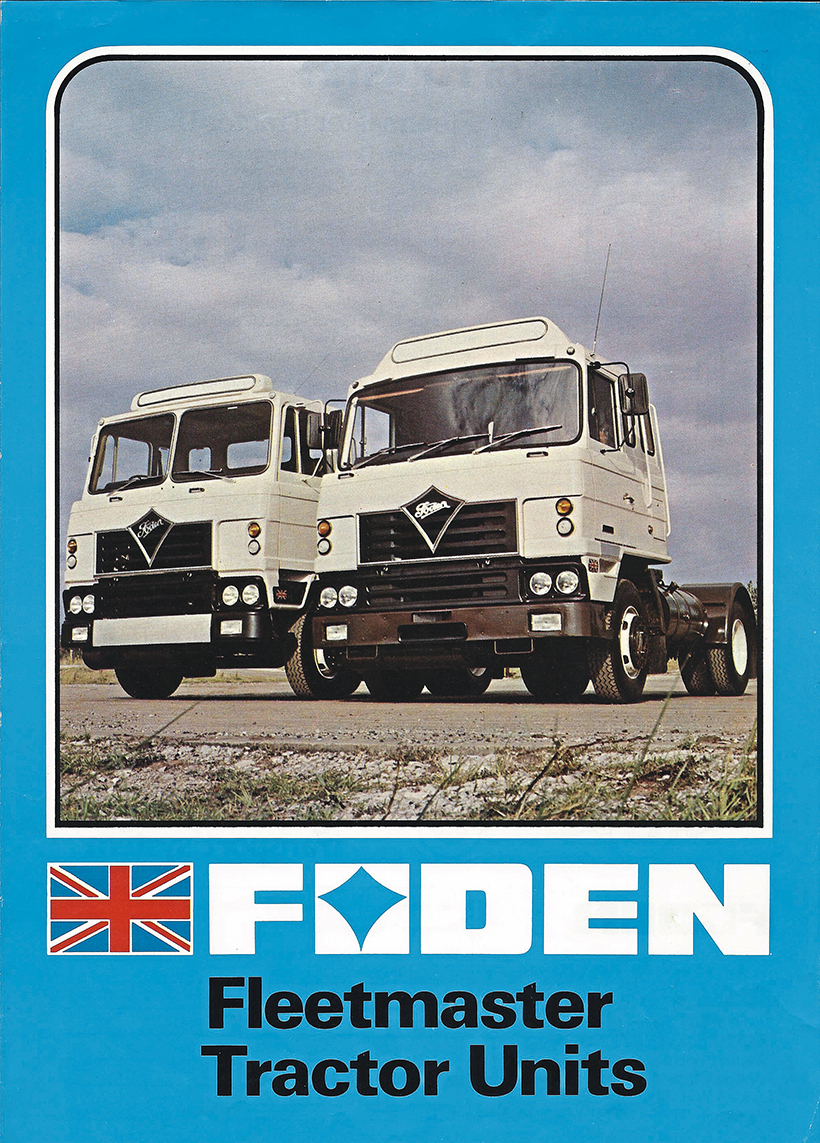
In print, the Foden Fleetmaster brochure for 1978.
YNO 957S was the registration given to the first Foden Fleetmaster to see the light of day. Unveiled to the press and invited guests at the Europa Hotel in central London, on 3rd November 1977, it was first shown to the public at the Scottish Commercial Vehicle Show at Kelvin Hall, Glasgow, later that month and launched as Fodens’s 1978 model. It was displayed resplendent in Foden’s factory white and brown livery, alongside the S83-cabbed derivative with large diameter single headlamps, the Fleetmster’s twin units instantly making it look more modern, while the cabs told their own story. The Motor Panels of Coventry pressed steel tilting cabs were essentially the same shell but offered as the S90 Haulmaster and the S95 Fleetmaster and Motor Panels’ own brochure showed the interchangeability between day cab and sleeper variants, either of which could be specified with single or two-piece windscreens, depending upon market versions, but at launch Foden announced the Fleetmaster as a day-cab only, with a sleeper option of the steel cab from 1978 and the GRP S10 becoming standard on tractor units.
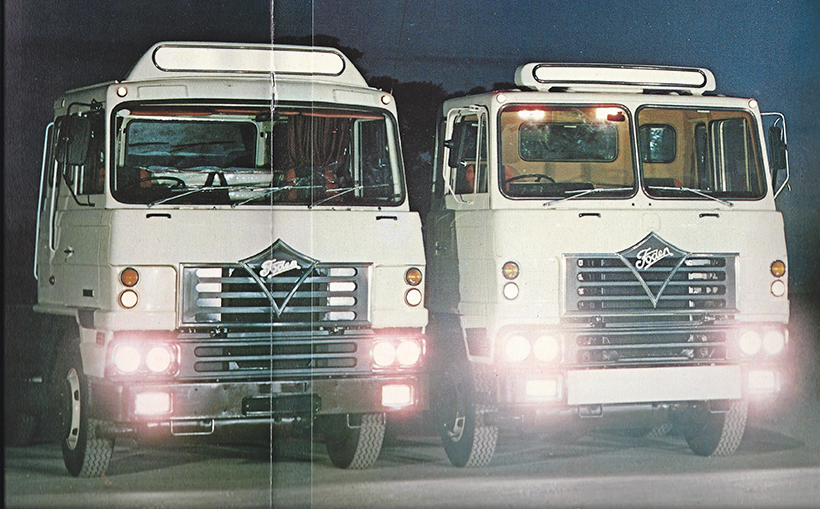
Showing cab and windscreen options.
Some hard-bitten fleet operators even insisted on the two-piece windscreen – cab type irrelevant – and Foden even produced its own new S10, GRP composite cab with a split screen also. However, that was all in the future, making this original launch truck even more of a rarity, even among Fleetmasters. As if that were not enough to single it out, it was later the recipient of a Jennings Coachwork of Crewe, sleeper cab conversion, the main extension section of which is itself GRP and forms the replacement roof, giving a total of 15 inches greater cab depth. It was first delivered as a day-cab with one-piece screen to Greenwoods, the UK-wide distribution operator (part of Amey Roadstone) and was the second Fleetmaster – after its starring role in the truck press – to be delivered to the company’s Hoddesdon base, making it the 100th Foden to pass through the haulier’s hands in 40 years.
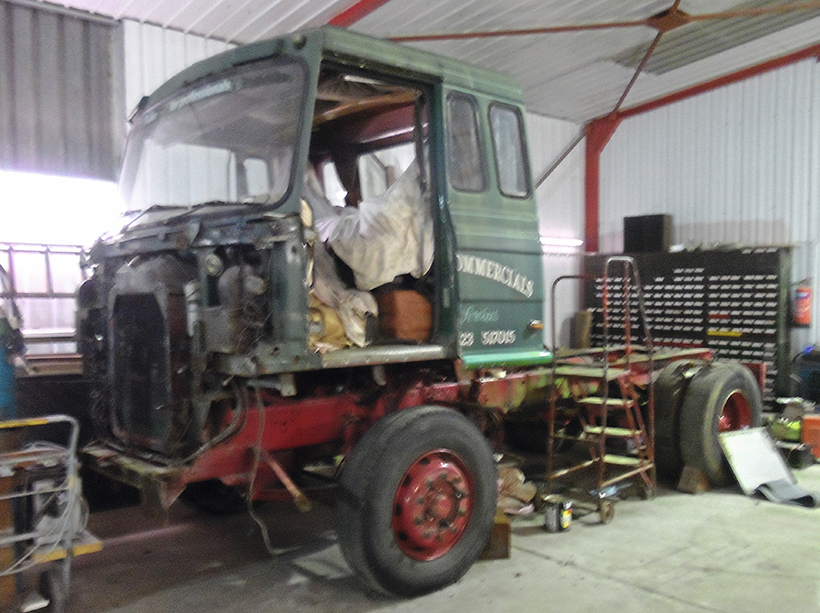
The restoration gets under way back in January 2015.
It would later pass into the hands of F&SJ Curry – now with its Jennings sleeper conversion – on general haulage work, in their blue and white colours before being bought by Steve Mayle Commercials of Mansfield in 1988. A change of colour to red and grey saw the Fleetmaster on general haulage and tipper duties, before its last colour change in service gave it a green and red livery under the Mayle Trailer Rentals banner. Giving up full-time driving Steve Mayle then carved out a reputation as one of the UK’s pre-eminent classic truck restorers, finally turning his attentions to his own Fleetmaster, initiating a six-year rebuild.

Long before that, however, YNO 957S had come in for plenty of attention in print. Both Commercial Motor and the since sadly departed Truck magazine each subjected it to a stringent road test program. Rightly so, the Fleetmaster was the latest model from one of Britain’s greatest heavy truck makers and as a broad model type was the last true Foden before the Paccar takeover in 1980. The subsequent Alpha model being little more than a re-badged DAF.
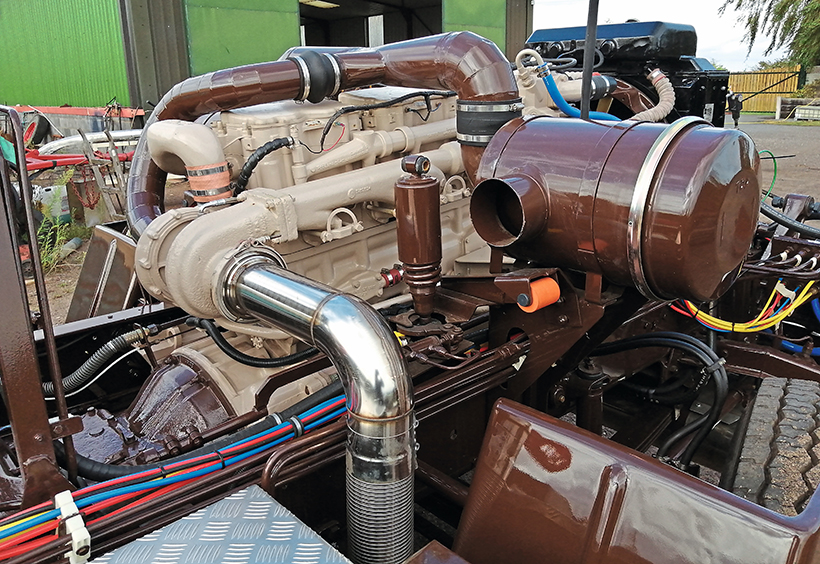
The rebuilt engine looks brand new.
In the late 1970s, Foden was struggling to keep pace. The S80/S83 cab with split-windscreen looked dated and not only were the likes of Volvo and Scania gathering pace with long-distance operators but even in the UK’s traditional ‘fleet’ sector, dominated by day cabs and Gardner 240s things looked bleak. Not only were Bedford and Ford outselling Foden but ERF and Seddon-Atkinson – doyens of the component truck genre – where outstripping the kite badge. In 1977, Foden sold 1,095 trucks above 15-tonnes in the UK, only 485 of which were tractor units, while family-feuders ERF saw 2,180 trucks leave their end of Sandbach and 3,100 new ‘Seddon-Atkis’ found homes.
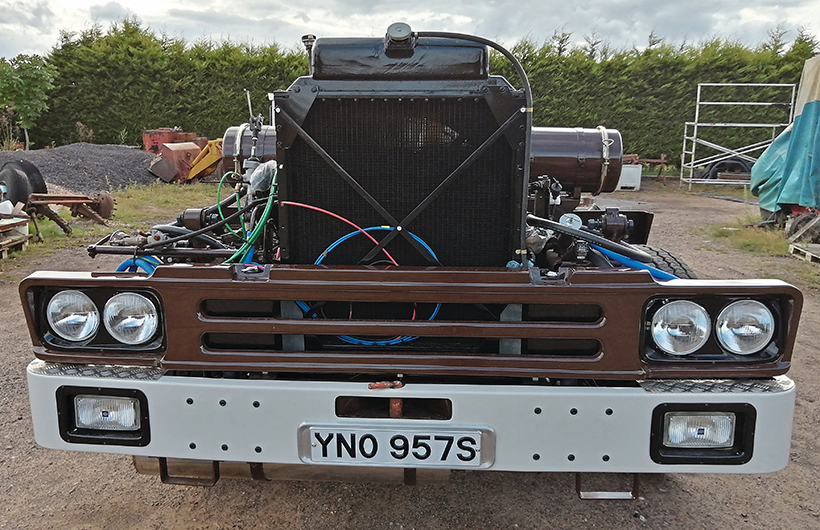
Engine re-installed in the chassis.
The new truck’s specification made for interesting reading. Although the Haulmaster was more traditional with a Foden eight-speed range-change gearbox and worm-drive axle, the Fleetmaster was intended to take the fight to the emerging Swedish brands with a Fuller RTO959A constant-mesh twin-countershaft unit boasting a direct-drive top in its nine-speed range change arsenal, and a single-reduction, 3.7:1 hypoid-bevel Rockwell 180 drive axle with lockable differential. As was accepted practice then, a wide engine choice would be available to suit individual operator preference with Cummins E290, Gardner 6LXC and Rolls-Royce 260L and 290L. Foden had shown a prototype of what was to become the Fleetmaster at the Amsterdam show back in 1974 sporting a Cummins NTC 335hp lump, but had elected not to offer it in two-axle models, presumably to assist in further separation from the three-axle Super Haulmaster (Universal) and export variants.

Motor Panels and Jennings jigsaw completed.
The Cummins E290 fitted to YNO 957S dwarfed the output of the traditional Foden-operators’ favourite, the Gardner. In 6LXC guise it produced 201 bhp at 1920rpm and 579lb.ft of torque at 1100 rpm. The Big-Cam Cummins 14 NTE some 390 bhp at 1,900 rpm and 930 lb.ft at 1,300 revs. With 33.7mph per every 1,000rpm being available in top gear of the Fuller nine-speed this equated to a healthy 64 mph at maximum power and 44 mph at the torque peak. It was this combination of engine and gearbox which although used elsewhere at the time drew comment from Commercial Motor of it working ‘particularly well’ in the Foden. It was a reasonably compact unit too, sitting upon a wheelbase of 3430mm (11ft 3 in) it had a 6.6 tonne capacity front axle – one of the few true Foden components left – with 4.7 turns lock-lock from its Burman steering gear and 11 tonne rear axle courtesy of Rockwell.
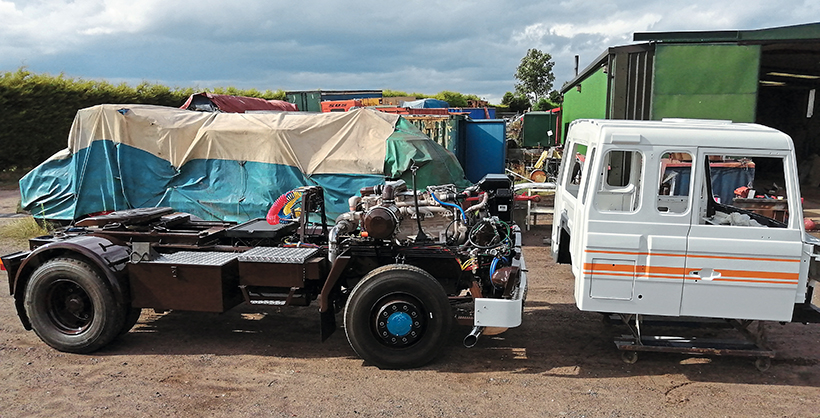
Cab ready for re-mounting.
The overall length stood at 5,700mm (18ft 8in) and width at a full 2500mm (8ft 2.5in). Unladen with day-cab it weighed 7,140 kg (7.02 tons) and had a design GCW of 32,420 kg (32 tons). In November 1977, it cost £22,590 without options. Commercial Motor took YNO 957S around its demanding Scottish test route, at 32 tons returning some impressive fuel figures, not least of which was an overall consumption of 7.34mpg. However, along the way, it praised the Cummins for its Gardner-esque ability to lug along at low revs, the magazine saw a brim-to-brim figure of 12 mpg along the relatively flat section between Gretna and Hamilton services, the magazine’s scribe admitting that had they been using a flow meter rather than the good old fashioned method, he’d have questioned the equipment’s accuracy. It came in for particular praise over the arduous sections of the A68 from Rochester to Neville’s Cross and to illustrate the perfect matching of the 14-litre turbo Cummins’ torque curve and the Fuller nine-speed’s ratio spread, between Forton services and Gretna it was only necessary to change out of top gear once! Truck magazine achieved slightly less overall on its road test at 6.74 mpg although their route had a rather different mix of road types.
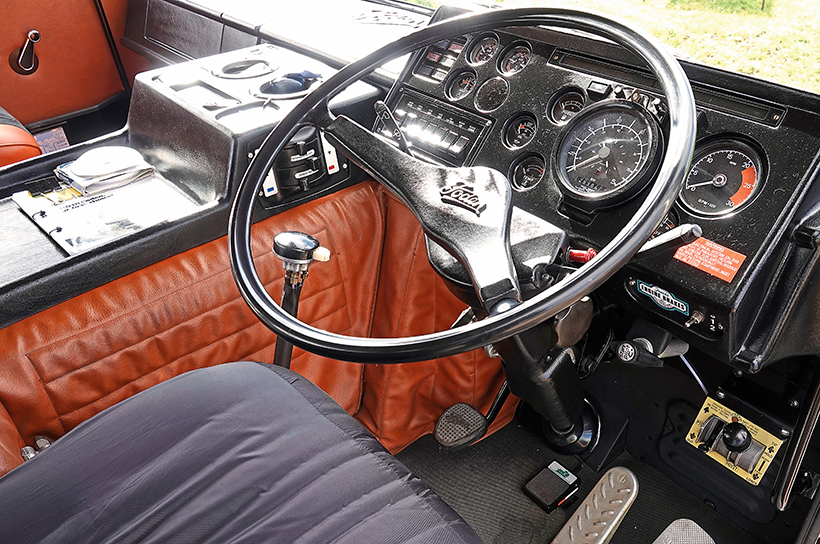
Colour matching the interior was quite a task.
In Steve Mayle’s hands, the Fleetmaster certainly saw a mix of work types too. Operating both on general haulage, trailer rental and even with a fifth wheel-mounted load body and drawbar trailer for specialist jobs. It was finally taken off the road in January 2015. The pictures from Steve’s archive show the extent of the rebuild, in other words; total.

Cab interior is superb, complete with overhead CB radio (it was the ‘70s, Good Buddy).
Once the cab and chassis had parted company, the engine, driveline and all ancillaries were removed to enable any corrosion on the chassis to be addressed before painting. This was where the first big decision had to be made. Most restorers when working on their own truck would normally put it back into the condition and colours of their fleet, indeed we often see older trucks brought up to date in the company’s current livery – which seldom works, to the honest. Steve went in the opposite direction. The Fleetmaster would be restored to its original launch colours, such is the model’s rarity and this actual chassis’ significance, that it would be a tough choice to do otherwise and hence the chassis was repainted back to the original chocolate brown. Allied to a white cab with orange striping, its sounds like a disaster if you say it out loud, but in the metal it works really well – whoever thought it up at Sandbach all those years ago certainly knew their stuff.

Jacobs exhaust brake, a later addition.
The engine and drive train came in for a total rebuild too. One of the few additions made to this truck during Steve’s operations with it, was the separate Jacobs ‘Jake brake’. Foden’s application was for it to operate through the service brake to ensure the brake linings did not remain unused – a practice later ‘reversed’ in more modern 38/41 tonners where the hydraulic retarder applied the wheel brakes slightly for the same reason. In this Fleetmaster, however, Steve preferred to separate the functions, hence the ‘fourth pedal’ on the cab floor.
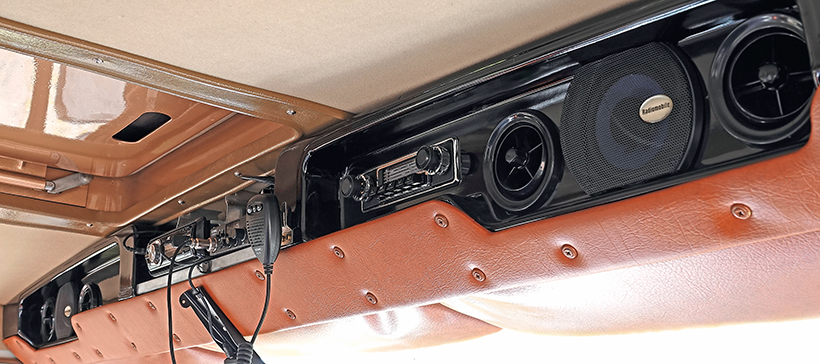
The rebuild is best described as fastidious, not only does the big-cam 14-litre look like it’s just arrived from Cummins in a crate, the routing of pipes and cables, the correct colour coding of said to match archive pictures, the replacement of the original (and very ‘70s) Fuller windscreen decal and the cab window sticker highlighting the original corrosion inhibitors applied to the Motor Panels cab, has been replaced too. The cab interior tells a similar tale. This was a lengthy process, since not only is this a Jennings Coachworks converted sleeper cab, not a Motor Panels factory sleeper, it’s a combination of sheet steel and GRP, which differ in their requirements for prep. and paint about as much as it’s possible to imagine. It would actually be easier to paint a piece of chalk and a piece of cheese and get a finish match. Nevertheless, that has been achieved, although you could not compare the vehicle now with the factory paint finish of course, simply because today it’s far better than it ever would have been in late ‘77.
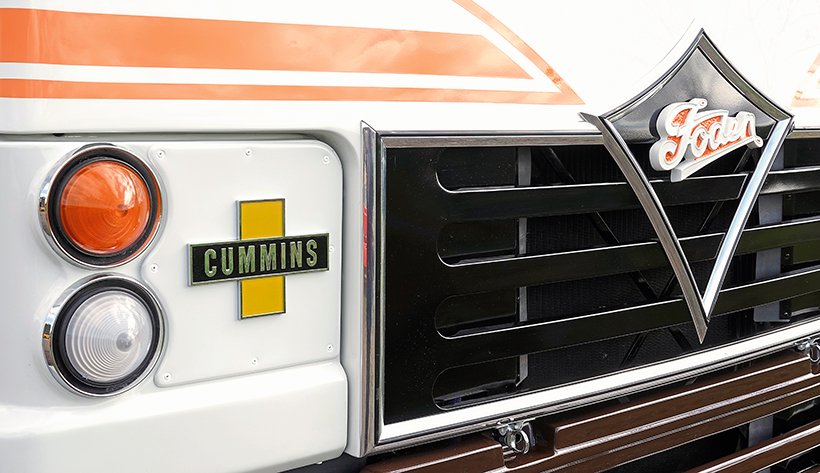
All correct period details, everywhere you look.
The cab interior too is show standard with nice touches that also show the trucks working heritage. “Matching the seats, engine cover and door cards was difficult, we had to make them from different materials and source them from different suppliers,” explains Steve Mayle, but the final result is absolutely spot-on.
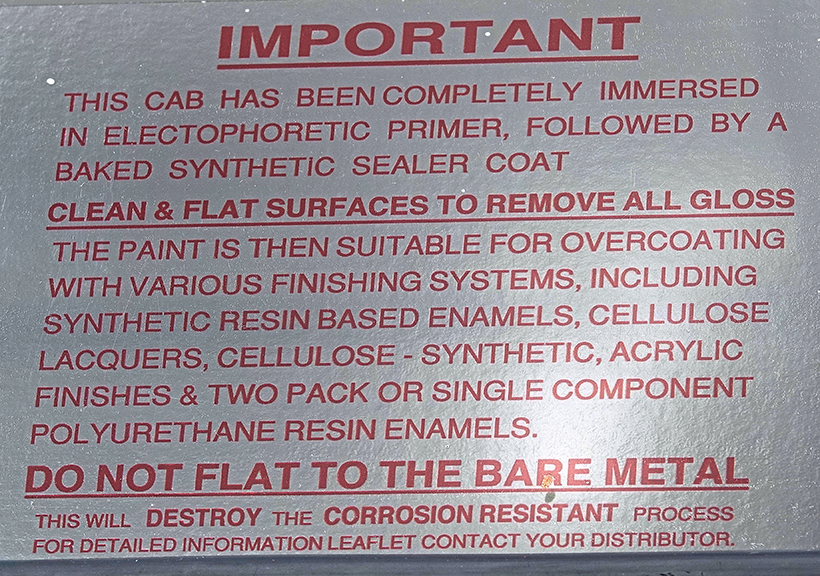
Original sticker declares corrosion resistance.
It sounds absolutely spot-on too. At start up the idle is expectedly smoother than the generation of engines which preceding it and the familiar Cummins 14-litre sound is instantly apparent. They have a familiar sound I’ve experienced from E250s in numerous ERFs and Seddon-Atkinsons through to an E335 version in a Ford Transcontinental and all have the same base tone. Out on the road this one has a decent level of performance too – as you’d expect in a solo two-axle tractor unit – and from inside or out it’s commendably free of transmission noise, suspension transmit nor any hint of panel or glazing rattle. The Jacobs exhaust brake profoundly announces its operation – doubling as a warning sound to errant cyclists and the like. As Steve turns the Foden around for another run past the camera, you can hear the Jake brake from a good quarter of a mile away!
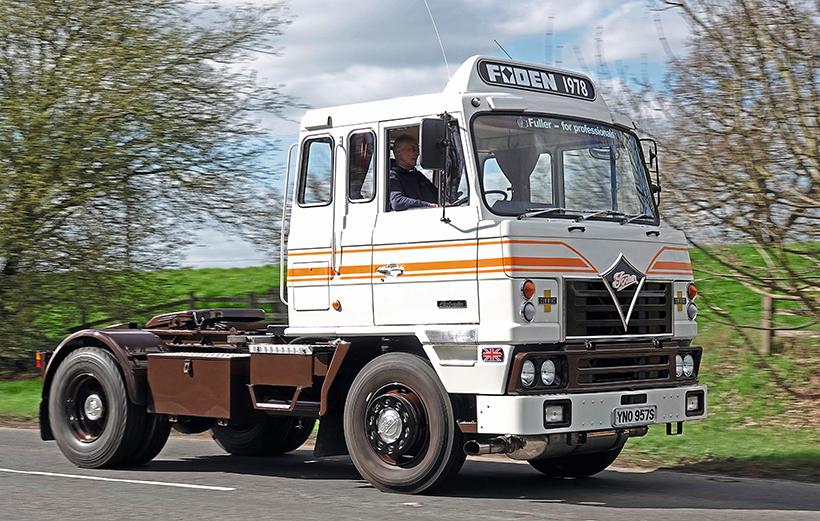
On the road the Fleetmaster looks (and sounds) just right.
That feeling of distance to be covered is quite fitting for the Fleetmaster. It was Foden’s great new hope at the time, giving the company a true contender to the face of a wave of DAFs, Scania-Varbis, and Volvo F86/88 all of which were already making inroads into the UK sector. Foden had to pretty much abandon all of its own components to achieve it however and invisibly join forces with rivals ERF and Seddon-Atkinson through their shared usage of bought-in engines and drivetrain against a backdrop of BL’s bulk usage of its most common parts from the empire. In the end it all proved to be too little too late and this was the last generation of Foden to claim any authenticity. After this re-badged (albeit with cosmetic cab highlights) DAF CF and XF trucks would form the Foden Alpha models under Paccar ownership. For this Fleetmaster however, the story continues, restored to its launch condition, it looks set to fly the kite for many years to come.
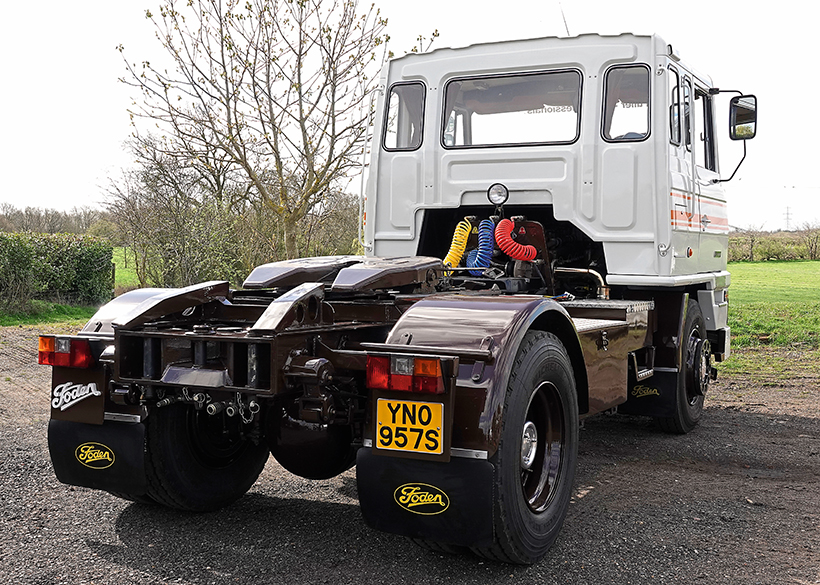
The author wishes to thank owner Steve Mayle for access to his comprehensive archive on the Fleetmaster.
This feature comes from the latest issue of Heritage Commercials, and you can get a money-saving subscription to this magazine simply by clicking HERE

Previous Post
Classic 1973 Bedford HA Post Office van beautifully preserved

Next Post
British National Ploughing Championships



